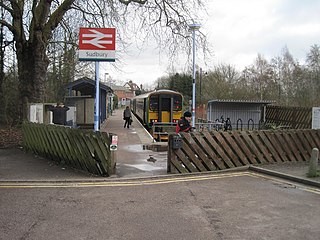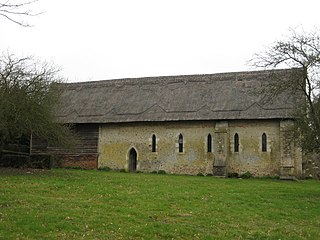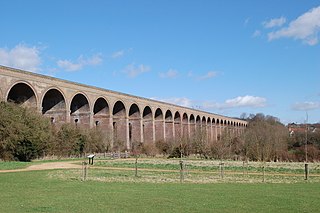
Sudbury is a market town in the south west of Suffolk, England, on the River Stour near the Essex border, 60 miles (97 km) north-east of London. At the 2011 census, it had a population of 13,063. It is the largest town in the Babergh local government district and part of the South Suffolk constituency.

Haverhill is a market town and civil parish in the county of Suffolk, England, next to the borders of Essex and Cambridgeshire. It lies about 14 miles (23 km) south east of Cambridge, south west of Bury St Edmunds, and north west of Braintree and Colchester.

The Gainsborough line is the current marketing name of the Sudbury branch line, a railway branch line off the Great Eastern Main Line in the east of England, that links Marks Tey in Essex with Sudbury in Suffolk. It is 11 miles 53 chains (18.77 km) in length and single-track throughout. The line's Engineer's Line Reference is SUD.

Cambridge railway station is the principal station serving the city of Cambridge in the east of England. It stands at the end of Station Road, 1 mile (1.6 km) south-east of the city centre. It is the northern terminus of the West Anglia Main Line, 55 miles 52 chains (89.6 km) down the line from London Liverpool Street, the southern terminus.

The Eastern Union Railway (EUR) was an English railway company, at first built from Colchester to Ipswich; it opened in 1846. It was proposed when the earlier Eastern Counties Railway failed to make its promised line from Colchester to Norwich. The businessman John Chevallier Cobbold and the engineer Peter Bruff were prominent in launching the company. The allied but nominally independent Ipswich and Bury Railway built a line onwards to Bury St Edmunds, also opening in 1846, and soon amalgamated with the EUR.

Sturmer is a village in the county of Essex, England, 2 miles (3 km) SE of Haverhill and close to the county border with Suffolk. Its name was originally "Stour Mere", from the River Stour and is explicitly mentioned in the Domesday Book of 1086. A Tudor illustration of the mere from the summer of 1571 exists in the National Archives. The mere still exists today to the east of the village. The village also gives its name to the Sturmer Pippin apple which was raised by Ezekiel Dillistone from 1831, and grown in the orchards of the village.

Marks Tey railway station is on the Great Eastern Main Line (GEML) in the East of England, serving the large village of Marks Tey, Essex. It is 46 miles 49 chains (75.02 km) down the line from London Liverpool Street and on the GEML is situated between Kelvedon to the west and Colchester to the east. Marks Tey is also the southern terminus of the Gainsborough Line to Sudbury. Its three-letter station code is MKT. The "up" (London-bound) platform 1 has an operational length for nine-coach trains, the "down" (Colchester-bound) platform 2 can accommodate 11-coach trains and platform 3 has an operational length for two-coach trains.

Sudbury railway station is the northern terminus of the Gainsborough Line, a branch off the Great Eastern Main Line in the East of England, serving the town of Sudbury, Suffolk. It is 11 miles 67 chains (19.05 km) down the line from the southern terminus of Marks Tey and 58 miles 32 chains (93.99 km) measured from London Liverpool Street; the preceding station on the branch is Bures. Its three-letter station code is SUY. The platform has an operational length for two-coach trains.

Long Melford, colloquially and historically also referred to as Melford, is a large village and civil parish in the Babergh district, in the county of Suffolk, England. It is on Suffolk's border with Essex, which is marked by the River Stour, 3 miles (4.8 km) from Sudbury, approximately 16 miles (26 km) from Colchester and 14 miles (23 km) from Bury St Edmunds. It is one of Suffolk's "wool towns" and is a former market town. The parish also includes the hamlets of Bridge Street and Cuckoo Tye.

Bures St Mary is a civil parish in the Babergh district of the English county of Suffolk. In 2005 it had a population of 940, reducing to 918 at the 2011 Census. The parish covers the eastern part of the village of Bures, the western part being in the Bures Hamlet parish in Essex divided by the River Stour.

Bures railway station is on the Gainsborough Line, a branch off the Great Eastern Main Line to Sudbury, in the East of England, serving the village of Bures, which straddles the counties of Essex and Suffolk.

Chappel & Wakes Colne railway station is on the Gainsborough Line, a branch to Sudbury off the Great Eastern Main Line, in the East of England, serving the village of Wakes Colne and the neighbouring Chappel. It is 3 miles 49 chains (5.81 km) down the line from Marks Tey and 50 miles 18 chains (80.83 km) measured from London Liverpool Street. It is situated between Marks Tey and Bures. Its three-letter station code is CWC. Platform 1 has an operational length for five-coach trains. Platforms 2 and 3 are used by the East Anglian Railway Museum.

Shelford railway station is on the West Anglia Main Line serving the villages of Great Shelford, Little Shelford and Stapleford in Cambridgeshire, England. It is 52 miles 36 chains (84.4 km) down the line from London Liverpool Street and is situated between Whittlesford Parkway and Cambridge. Its three-letter station code is SED.

Hythe railway station in Essex is on the Sunshine Coast Line, a branch of the Great Eastern Main Line in the East of England, serving Hythe and other eastern areas of Colchester. It is 53 miles 49 chains (86.3 km) down the line from London Liverpool Street. Its three-letter station code is HYH.

Chappel is a village and civil parish in the City of Colchester district of Essex, England. The River Colne flows through the village. It is significant for its Victorian viaduct, which crosses the Colne valley.
The Colne Valley and Halstead Railway (CVHR) is a closed railway between Haverhill, Suffolk and Chappel and Wakes Colne, Essex, in England.

Long Melford railway station is a disused station that served the village of Long Melford in Suffolk, England. It opened in 1865 as "Melford" and was renamed "Long Melford" in 1884. The station was on the Stour Valley Railway between Sudbury and Cambridge, operated by the Eastern Counties Railway, as well as a branch line between Sudbury and Bury St Edmunds. Services over the latter route ended in 1961 and the station and Stour Valley line closed in 1967 as part of the Beeching cuts. The station building is now a private residence.
The Long Melford–Bury St Edmunds branch line was a railway between Long Melford on the Stour Valley Railway and Bury St Edmunds on the Ipswich to Ely Line. The line opened on 9 August 1865 and closed to passengers on 10 April 1961 and freight on 19 April 1965.

Haverhill railway station was a station in Haverhill, Suffolk, on the Stour Valley Railway, which opened in 1865 and closed in 1967. It was sometimes known as Haverhill North because of a separate station in the town on the Colne Valley and Halstead Railway.

The Chappel Viaduct is a railway viaduct that crosses the River Colne in the Colne Valley in Essex, England. It carries the Gainsborough Line which now is a short branch linking Marks Tey in Essex to Sudbury in Suffolk. The line previously, however, extended to Shelford in Cambridgeshire.


















